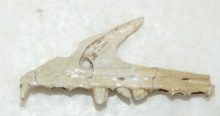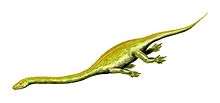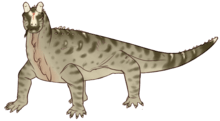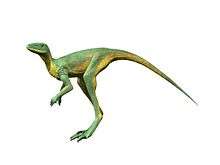Agnosphitys
Agnosphitys (/ˌæɡnoʊsˈfaɪtɪs/; "unknown begetter"; sometimes mistakenly called Agnostiphys or Agnosphytis) is a genus of silesaurid dinosauriform that lived during the Late Triassic. It contains only one species, the type species A. cromhallensis. Its remains include an ilium, maxilla, astragalus and humerus, which date variously from the Norian and Rhaetian stages of the Late Triassic, or possibly as late as the Hettangian stage of the Early Jurassic.[1] The fissure fill at Avon, of which Agnosphitys was probably recovered from, was a sinkhole formed by the dissolution of Lower Carboniferous limestones.
| Agnosphitys | |
|---|---|
 | |
| Referred left maxilla | |
| Scientific classification | |
| Kingdom: | Animalia |
| Phylum: | Chordata |
| Clade: | Dracohors |
| Clade: | †Silesauridae |
| Genus: | †Agnosphitys Fraser et al., 2002 |
| Species: | †A. cromhallensis |
| Binomial name | |
| †Agnosphitys cromhallensis Fraser et al., 2002 | |
Discovery and naming
The type species, Agnosphitys cromhallensis, was described by Nicholas Fraser, Kevin Padian, Gordon Walkden and A. L. M Davis in early 2002.[2] The fossils consist of two specimens. The holotype consists of a single isolated left ilium, while the second specimen consists of a partial skeleton including a left maxilla, a humerus and a left astragalus, were found in Avon, England (possibly recovered from the Avon Fissure Fill).[3]
Classification

The remains of Agnosphitys defied precise classification in the original description; the describers placed it outside Dinosauria using the definition of Dinosauria outlined by Padian and May (1995) and provided (on p. 80) the following diagnosis: "Well-defined brevis fossa on the ilium; semi-perforate acetabulum; `kidney-shaped' antitrochanter; well-developed posterior portion of the iliac blade; two sacral vertebrae; subrectangular deltopectoral crest that is 33 per cent of the length of the humerus; astragalus with a distinct ascending process and a prominent depression immediately posterior to the ascending process; in dorsal aspect an acute anteromedial corner on the astragalus."[2]
Despite the paucity of known fossils, Agnosphitys has been included in two phylogenetic analyses analyzing primitive dinosaur relationships. Yates (2007) recovered the genus as a theropod,[4] whereas Ezcurra (2010) recovered it as a member of Guaibasauridae.[5] More recently, Agnosphitys has been considered a silesaurid based on an as-yet-unpublished description of Asilisaurus.[6]
A large phylogenetic analysis of early dinosaurs and dinosauromorphs carried out by Matthew Baron, David Norman and Paul Barrett (2017) recovered Agnosphitys as a member of the clade Silesauridae.[7]
References
- Langer, 2004. Basal Saurischia. In Weishampel, Dodson and Osmolska. The Dinosauria Second Edition. University of California Press. 861 pp.
- Nicholas C. Fraser, Kevin Padian, Gordon M. Walkden and A. L. M. Davis, 2002. Basal dinosauriform remains from Britain and the diagnosis of the Dinosauria. Palaeontology. 45(1), 79-95.
- Weishampel, David B; et al. (2004). "Dinosaur distribution (Early Jurassic, Europe)." In: Weishampel, David B.; Dodson, Peter; and Osmólska, Halszka (eds.): The Dinosauria, 2nd, Berkeley: University of California Press. Pp. 532–534. ISBN 0-520-24209-2.
- Yates, 2007. Solving a dinosaurian puzzle: the identity of Aliwalia rex Galton. Historical Biology. 19(1), 93-123.
- Ezcurra, 2010. A new early dinosaur (Saurischia: Sauropodomorpha) from the Late Triassic of Argentina: A reassessment of dinosaur origin and phylogeny. Journal of Systematic Palaeontology. 8(3), 371–425.
- Nesbitt, Sidor, Irmis, Stocker, Angielczyk, and Smith, 2015. THE ANATOMY OF ASILISAURUS KONGWE (DINOSAURIFORMES: SILESAURIDAE) AND CLOSELY-RELATED TAXA PROVIDES NEW INSIGHTS INTO THE ANATOMICAL AND CHRONOLOGICAL EVOLUTION OF DINOSAURIFORMS. Journal of Vertebrate Paleontology 35 (Supplement):187A-188A.
- Baron, M.G., Norman, D.B., and Barrett, P.M. (2017). A new hypothesis of dinosaur relationships and early dinosaur evolution. Nature, 543: 501–506. doi:10.1038/nature21700









